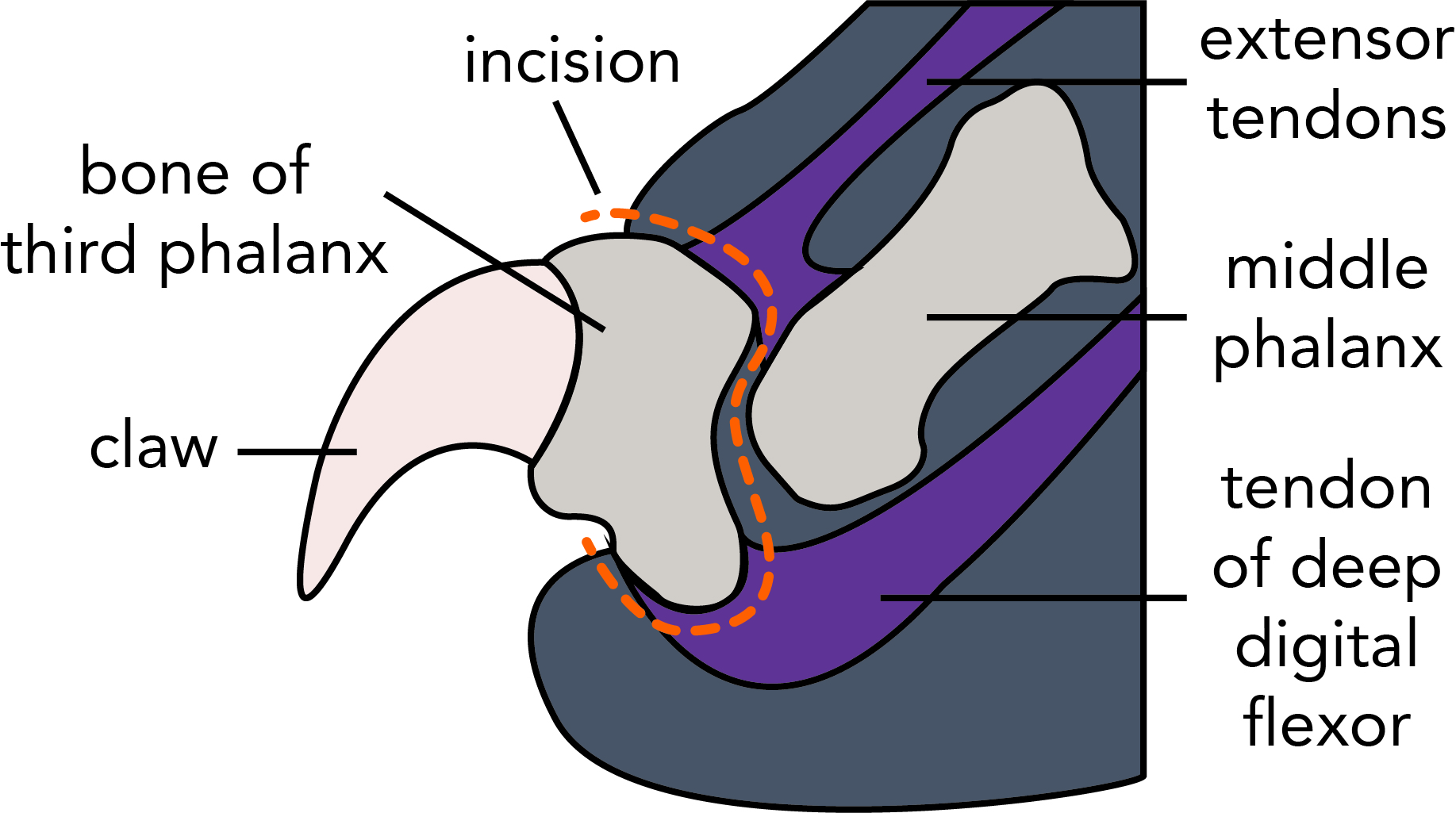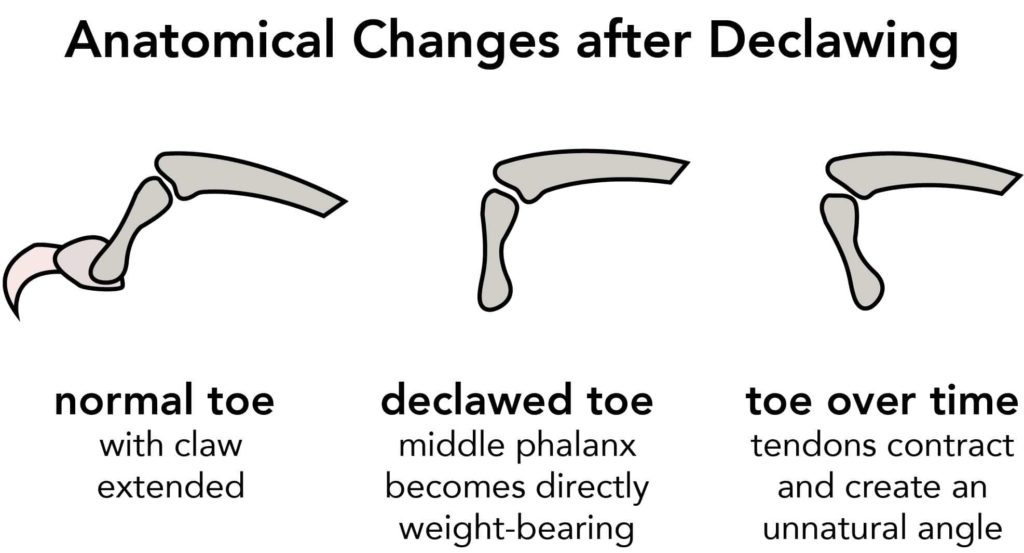
Declawing Our Feline Friends
Declawing cats has been the norm for decades. This routine procedure is usually performed on kittens to prevent unwanted scratching to both people and household property. Veterinary students have been taught this simple surgery with the assumption they would perform countless of them throughout their career.
However, the practice of declawing cats has recently become a hot topic in veterinary medicine around the world, including the United States. It has come under fire as an inhumane procedure and many people are lobbying to have the declawing procedure banned in the US.
“Onychectomy”: The Declawing Procedure
“Onych”, meaning fingernail or toenail + “ectomy”, meaning surgical removal of
Imagining the removal of a fingernail sounds painful enough, but in the case of a feline onychectomy, it’s actually a surgical amputation of a cat’s third phalanges (toe bones) with the attached claws. If this procedure was performed on a person, it would essentially be the equivalent of cutting off each finger at the last knuckle.

Prevent Destructive Habits at Home
Scratching Posts
- A good scratching post needs to be tall enough for your cat to extend for a full, satisfying stretch.
- It must be stable and not wobble when your cat uses it.
- Sisal fabric is better than rope-like scratching posts. The fabric gives good texture for the cats to scratch and shred rather than an interrupted, bumpy scratch that they get with a rope-based post.
- Place the scratching posts in an area of the house that your cat likes to spend time, as well as near the furniture your cat may be inappropriately scratching.
- Use natural cat pheromones such as Feliway or sprinkle Catnip on and around the scratching post to encourage your cat to use it.
Double Sided Tape on Furniture – StickyPaws
This will hopefully be a dissatisfying feeling when your cat tries to scratch. This approach may lead them to scratch somewhere else, so make sure appropriate scratching posts are available.
Gel Nail Caps – Soft Paws or Soft Claws
Placed over the claws, these can be used to blunt the nail points and prevent scratching.
- The nails must first be trimmed to allow proper placement of the gel nail caps.
- The gel caps are filled with a supplied nail glue, and then placed over the nail securely.
- Commercially available gel nail caps for cats typically last about 1 month after application.
- Unsure about applying nail caps on your cat by yourself? Furr: Pet Spa and Wellness has a cat groomer who is experienced in gel nail application.
Pros & Cons of Declawing
Pros:
- Reduced trauma to the owners – in immunocompromised individuals or those on blood thinners, declawing can dramatically reduce the chance of traumatic incidences to the owners.
- Won’t scratch furniture – obviously if nails aren’t there, they can’t scratch anything. But bad behavior can be humanely prevented with training and redirection. Gel caps can be placed over your cat’s nails to prevent them from scratching.
- Medical reasons for the cat – understandably in situations where there is severe trauma to the toes (attack, frostbite, etc.) or in cases of tumor growth, declawing can solve the problem.
Cons:
- It is extremely painful – pain management drugs are given and prescribed to help during surgical procedure and immediately after, but ultimately your cat is still in some degree of pain.
- Risk of surgical complications – as with any type of surgery, there is a risk of complications during and after surgery. This can include excessive bleeding, infection, or regrowth of the nail. Yes, you read that correctly. If a portion of the bone is left behind, it is possible the nail can grow over time. Certain surgical techniques are more prone to leaving bone fragments behind, which can be painful for your cat.
- Possibility of urinating outside the litter box – This goes along with bone fragments being left behind. A certain percentage of adult cats that urinate outside their litter box could be due to having bone fragments left behind. The theory behind this is that having those fragments left behind are uncomfortable, especially when using the litter box. This results in the cat peeing elsewhere. Claw fragments can be identified with x-rays, and would need to be surgically removed.
- Possible increased tendency to bite – some people have theorized that declawed cats are more likely to bite in threatening situations. The theory is, instead of being able to swat or scratch away perceived threats (including owners or family members), they will turn to biting. Typically, a cat bites is more severe, painful, and infectious than a scratch.
- Arthritis – Removing the last digit of the toe slightly alters the way a cat walks. Over time, this can lead to premature arthritis. Arthritis is an uncomfortable disease that can be debilitating in some pets, potentially leading to a shorter lifespan.

Worldwide Status of Declawing
Laws allowing feline onychectomy procedures vary in places around the world. The following countries have made it illegal to have your cat declawed, except for the medical need of the cat (not the owner):
- Australia
- Brazil
- Finland
- Ireland
- England
- Scotland
- Germany
- Austria
- Switzerland
- Italy
- Norway
- Denmark
- France
- Israel
- Sweden
- New Zealand
- Netherlands
At the time of writing this blog, New Jersey and New York are currently working on state legislation that would make it illegal to declaw your cat. There are currently eight cities in California that have banned the surgical procedure, including Los Angeles, San Francisco, Burbank, and Santa Monica.
If you are considering having your feline friend declawed, we strongly urge you to reconsider.
If there are certain behavioral issues leading you towards this painful procedure, we recommend following the tips outlined above as well as consulting with your veterinarian before scheduling a permanent surgical procedure.
